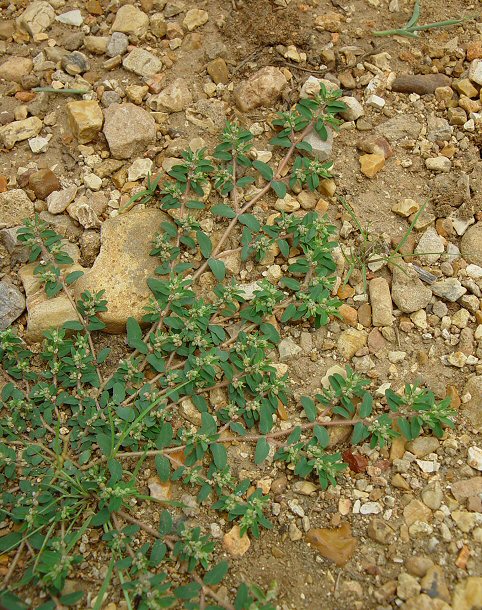Euphorbia maculata L.
Milk Purslane

Native
CC = 0
CW = 3
MOC = 72
© DETenaglia
Euphorbia maculata L.Milk Purslane | |
 |
Native CC = 0 CW = 3 MOC = 72 |
© DETenaglia |
|
Family - Euphorbiaceae Stems - From a single taproot, multiple from the base, branching, prostrate, herbaceous, terete, pilose at the base, moderately pilose to hirsute above, green to (more commonly) red, with milky sap, to +30cm long, forming mats.
Leaves - Opposite, short-petiolate. Petioles to 1mm long, pubescent as the stem. Blades oblique at the base, typically oblong to oblong-ovate, dull dark green above, whitish-green below, sometimes with a dark red splotch in the center, with few to many hairs above, much more hairy below, appearing entire but actually with shallow teeth along the entire margin, rounded at the apex, to +/-1.4cm long, +/-5mm broad. Main veins of the leaf all arising at the base of the blade, typically 3.
Inflorescence - Typically a single cyathium per leaf axil, appearing dense because of the short internodes of the upper stems. Flowers - Involucre of the cyathium green, -2mm long, glabrous or sparse strigose, with 4 glands at the apex. Glands olive green, with small white to pinkish appendages. Appendages to .5mm broad, .3-.4mm long. Cyathia with a few hairs at the apex internally. Stamens 1-2 per cyathium. Filaments white, glabrous, .5-.7mm long. Anthers yellowish with some red, bilobed, .3mm broad. Capsule usually at 90 degrees to the cyathium, strigose, green, to -2mm long, 3-locular. Styles 3, .4-.5mm long, translucent, divided in apical 1/3 - 1/4, glabrous. Seeds 1-1.1mm long, brownish-purple when mature, with weak crossed ridges between the angles. Ridges coarse and few.
Flowering - May - October. Habitat - Waste ground, disturbed sites, cultivated ground, along sidewalks and streets, roadsides, railroads, glades. Origin - Native to U.S. Other info. - This little species can be found throughout Missouri and is quite common. It is one of the most common weeds in the state and in the eastern U.S. Photographs taken in Van Buren, MO., 7-18-03. |